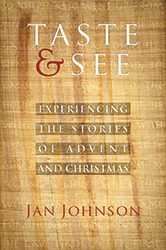 Advent devotionals are among my absolutely most favorite things in the world.
Advent devotionals are among my absolutely most favorite things in the world.
Each year, as the crisp breezes of fall give way to the sharper chills of winter, I begin my search. For weeks, I browse the shelves of local bookstores, traipse the digital trails of Google and Amazon, and ask friends for recommendations. Last year, I settled on Watch for the Light, a delightful and thought-provoking collection of readings by various theologians and artists. The year before, it was Dietrich Bonhoeffer’s God is in the Manger. I’ve worked my way through Henri Nouwen’s Advent and Christmas Wisdom and John Kruse’s collection of St. Francis’s work on Advent and, after receiving Ann Voskamp’s The Greatest Gift last year for Christmas, I have been waiting nearly a year for the 2014 season to roll around to dive in to this latest work by one of my favorite authors.
But this year is an especially lucky one: even though it’s only October, I’ve had the opportunity to celebrate Advent early via Jan Johnson’s wonderful Taste and See: Experiencing the Stories of Advent and Christmas.
Taste and See, though designed for small groups, could just as easily be adapted for personal meditation. It is divided into four sections, each consisting of a week’s worth of readings, each week centering on one narrative moment: Zechariah and Elizabeth’s blessing, Mary’s preparation, Joseph’s Challenge, and the Birth of Christ (there is also a Post-Advent Section focusing on the Magis’s visitation). The plan assumes that the small group will meet once a week, and individuals will work their way through the readings solo on the other six days. There are details for leaders on how to run the group sessions, but in general, those who are using the text for personal study will just find that one day’s devotion will be more conversation-oriented and in-depth (a good thing!) as it is intended for group work.
What sets Taste and See apart from other Advent devotionals I’ve encountered is Johnson’s focus on training readers in the practice of meditation: Johnson emphasizes the importance of understanding the meaning, purpose, and value of meditation and then leads readers through the process of meditation. In the Introduction, Johnson writes:
“The focus of our time together will be much more than to remember the Christmas story. We will aim to experience the events of Christmas ourselves. This guide invites you to ‘taste and see,’ to imagine the tangible elements in the stories and the probable feelings of the characters. Historical and cultural facts provide context and a means of stepping into these events and these lives for a while. While you probably are embarking on this study in order to celebrate Christmas in a meaningful way…be prepared for God to speak to you in ways that meet deep needs within you.”
The reading technique Johnson recommends is what she calls “participative meditation” where readers strive to “become a part of the story.” For those entirely unfamiliar with intensive or immersive meditation, Johnson makes the process simultaneously exciting, unintimidating, and practical. She offers tips for the best environment for meditation and how to relax and focus. The days intended for group work—with their more detailed exploration of the text—are actually very helpful for modeling what this approach looks like. The sessions begin with a prayer, move on to the reading, suggest key phrases from the passage to examine more closely, offer questions to consider and “cues” to help readers imagine themselves in the story, and provide action points for how to incorporate the experience and spiritual lessons from the passage into our lives.
Such an approach is especially effective for the Christmas story. Being the Bible narrative we have heard more often than perhaps any other (besides Easter?), the act of revisiting it with the intent to revive its initial impact and, likely for the first time for many of us, experience it as if we were living it ourselves proves invaluable. The Christmas story also works well with this approach because it requires us to step back and take quite a bit of time with the central event of the season. To truly immerse oneself in the scenes described, to fully think through each question posed, to fully evoke each sensory or historical detail noted takes a lot of focus, intentionality, and time. During a time of year that often is characterized by the hustle and bustle of shopping, traveling, and celebrating, a time associated with the sensory overload of brightly colored lights and thrilling music and sweet and savory dishes galore, Johnson encourages us to treat the days leading up to Christmas day as opportunities to rest our minds and hearts and center them on the more rare and beautiful anticipation and excitement that Scripture has to offer.
Laying out the blocks of time (at least an hour for each devotion, for me) to take part in the detailed and immersive experience of the Christmas story that Taste and See offers will perhaps be harder at Christmas-time than at any other time of the year. But that is also precisely why it is so important.
 Amber M. Stamper holds a Ph.D. in English (Rhetoric and Composition) and is an Assistant Professor of Language, Literature, and Communication at Elizabeth City State University in North Carolina. Her research and publications center on religious rhetoric and communication, especially issues of Christian evangelism and the digital church.
Amber M. Stamper holds a Ph.D. in English (Rhetoric and Composition) and is an Assistant Professor of Language, Literature, and Communication at Elizabeth City State University in North Carolina. Her research and publications center on religious rhetoric and communication, especially issues of Christian evangelism and the digital church.












